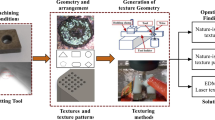Abstract
The machining of quartz due to hard, non-conducting and brittle behavior with desired accuracy and precision is always a challenge. Quartz is widely used in MEMS/MOEMS applications. However, wire electrochemical discharge machining (WECDM) has great potential to machine hard and brittle materials like quartz, glass FRP, etc. The WECDM process is a hybrid non-conventional manufacturing process which combines characteristics of electrochemical machining (ECM) and wire-electrical discharge machining (W-EDM). The present study discusses the investigation of the effect of the governing process parameters such as voltage, electrolyte concentration, and wire speed (feed) on material removal rate (MRR) and surface roughness (Ra) during the micro-machining of quartz using self-developed tabletop desktop WECDM setup. The hybrid methodology of Taguchi orthogonal arrays and Analysis of variance (ANOVA) is used to find the optimum parameters and their significant contribution to response parameters respectively. Experimental results reveal that a better surface finish and high material removal rate was obtained by zinc layered brass wire (150 μm diameter). The machining of quartz under the zinc layered brass wire can indeed enhance the surface quality characteristics and material removal rate. Also, the mathematical models were established in order to derive the relationship between input and response parameters which was successfully validated by the confirmation experiment. Furthermore, the machining quality observed by a Scanning electron microscope (SEM), reveals the presence shallow cracks at higher-end input parameters.
Similar content being viewed by others
References
Singh J, Vaishya R, Kumar M (2019) Fabrication of microfeatures on quartz glass using developed WECDM setup. ARPN J Eng Appl Sci 14:725–731
Puttick KE, Rudman MR, Smith KJ, Franks A, Lindsey K (1989) Single-point diamond machining of glasses. Proc R Soc Lond A 426:19–30. https://doi.org/10.1098/rspa.1989.0116
Guzzo PL, Raslan AA, De Mello JDB (1999) Relationship between quartz crystal orientation and the surface quality obtained by ultrasonic machining, in joint meeting. Micropolis 792–795. https://doi.org/10.1109/FREQ.1999.841424
Fabian S, HlavᡠLM, HlavᡠIM et al (2009) Experimental method for the investigation of the abrasive water jet cutting quality. J Mater Process Technol 209:6190–6195. https://doi.org/10.1016/j.jmatprotec.2009.04.011
Hildebrand J, Hecht K, Bliedtner J, Müller H (2011) Laser beam polishing of quartz glass surfaces. Phys Procedia 12:452–461. https://doi.org/10.1016/j.phpro.2011.03.056
Jain VK, Rao PS, Choudhary SK, Rajurkar KP (2016) Experimental investigations into Traveling Wire Electrochemical Spark Machining (TW-ECSM ) of composites. J Eng Ind 113:75–84. https://doi.org/10.1115/1.2899625
Oza AD, Kumar A, Badheka V, Arora A (2019) Traveling Wire Electrochemical Discharge Machining (TW-ECDM) of quartz using zinc coated Brass wire: investigations on material removal rate and kerf width characteristics. Silicon. https://doi.org/10.1007/s12633-019-0070-y
Yang CT, Song SL, Yan BH, Huang FY (2006) Improving machining performance of wire electrochemical discharge machining by adding SiC abrasive to electrolyte. Int J Mach Tools Manuf 46:2044–2050. https://doi.org/10.1016/j.ijmachtools.2006.01.006
Kuo KY, Wu KL, Yang CK (2015) Effect of adding SiC powder on surface quality of quartz glass microslit machined by WECDM. Int J Adv Manuf Technol 78:73–83. https://doi.org/10.1007/s00170-014-6602-0
Bhuyan BK, Yadava V (2014) Modelling and optimisation of travelling wire electro-chemical spark machining process. Int J Ind Syst Eng 18:139–158. https://doi.org/10.1504/IJISE.2014.064703
Rattan N, Mulik RS (2017) Experimental investigations and multi-response optimization of silicon dioxide (quartz) machining in magnetic field assisted TW-ECSM process. Silicon 9:663–673. https://doi.org/10.1007/s12633-016-9521-x
Rattan N, Mulik RS (2017) Improvement in material removal rate (MRR) using magnetic field in TW-ECSM process. Mater Manuf Process 32:101–107. https://doi.org/10.1080/10426914.2016.1176197
Bhuyan BK, Yadava V (2014) Experimental study of traveling wire electrochemical spark machining of borosilicate glass. Mater Manuf Process 29:298–304. https://doi.org/10.1080/10426914.2013.852216
Bhuyan BK, Yadava V (2014) Experimental modelling and multi-response optimization of travelling wire electrochemical spark machining of Pyrex glass. Proc Inst Mech Eng Part B J Eng Manuf 228:902–916. https://doi.org/10.1177/0954405413514745
Peng WY, Liao YS (2004) Study of electrochemical discharge machining technology for slicing non-conductive brittle materials. J Mater Process Technol 149:363–369. https://doi.org/10.1016/j.jmatprotec.2003.11.054
Mitra NS, Doloi B, Bhattacharyya B (2015) Predictive analysis of criterial yield during travelling wire electrochemical discharge machining of Hylam based composites. Adv Prod Eng Manag 10:73–86. https://doi.org/10.14743/apem2015.2.193
Malik A, Manna A (2016) An experimental investigation on developed WECSM during micro slicing of e-glass fibre epoxy composite. Int J Adv Manuf Technol. https://doi.org/10.1007/s00170-016-8858-z
Liu JW, Yue TM, Guo ZN (2009) Wire electrochemical discharge machining of Al2O3 particle reinforced aluminum alloy 6061. Mater Manuf Process 24:446–453. https://doi.org/10.1080/10426910802714365
Yadav P, Yadava V, Narayan A (2018) Experimental investigation of kerf characteristics through wire electrochemical spark cutting of alumina epoxy nanocomposite. J Mech Sci Technol 32:345–350. https://doi.org/10.1007/s12206-017-1234-6
Kuo KY, Wu KL, Yang CK, Yan BH (2013) Wire electrochemical discharge machining (WECDM) of quartz glass with titrated electrolyte flow. Int J Mach Tools Manuf 72:50–57. https://doi.org/10.1016/j.ijmachtools.2013.06.003
Basak I, Ghosh A (1996) Mechanism of spark generation during electrochemical discharge machining: a theoretical model and experimental verification. J Mater Process Technol 62:46–53. https://doi.org/10.1016/0924-0136(95)02202-3
Basak I, Ghosh A (1997) Mechanism of material removal in electrochemical discharge machining: a theoretical model and experimental verification. J Mater Process Technol 71:350–359. https://doi.org/10.1016/S0924-0136(97)00097-6
Crichton IM, McGeough JA (1985) Studies of the discharge mechanisms in electrochemical arc machining. J Appl Electrochem 15:113–119. https://doi.org/10.1007/BF00617748
Jain VK, Dixit PM, Pandey PM (1999) On the analysis of the electrochemical spark machining process. Int J Mach Tools Manuf 39:165–186. https://doi.org/10.1016/S0890-6955(98)00010-8
Author information
Authors and Affiliations
Corresponding author
Additional information
Publisher’s Note
Springer Nature remains neutral with regard to jurisdictional claims in published maps and institutional affiliations.
Rights and permissions
About this article
Cite this article
Kumar, M., Vaishya, R.O., Oza, A.D. et al. Experimental Investigation of Wire-Electrochemical Discharge Machining (WECDM) Performance Characteristics for Quartz Material. Silicon 12, 2211–2220 (2020). https://doi.org/10.1007/s12633-019-00309-z
Received:
Accepted:
Published:
Issue Date:
DOI: https://doi.org/10.1007/s12633-019-00309-z




